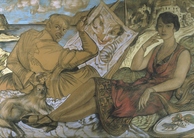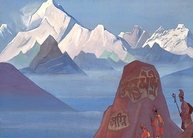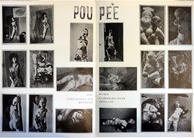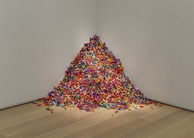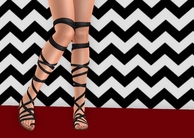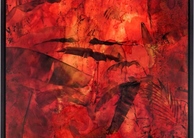Passing Time in The Garden of Earthly Delights by Hieronymus BoschJacobs, writing about this compositional division of the panels, notes that Bosch “divides each of the three inner scenes horizontally into three zones, creating a top and a bottom separated by a central body of water” (1040). The first of these zones being the rocky mountainous structures, and the second being, as she notes, the central body of water, in which the manmade structures reside. The bottom-most zone, then, would be that of the foreground, where the viewer begins travelling through each of the panels via the close-up action in each scene. In Paradise, the eye enters in on the moment in which God unites Adam and Eve. A wall of bushes or trees directly behind them, which brings this specific part of the scene closer to the viewer. This line of foliage flows into the Imaginary Paradise scene, separating the figures off in the distance from the larger, closer ones in the foreground. In Hell a wall of musical instruments replaces the like of foliage, and separates the suffering in the background from the groups of figures suffering in the front. In each of the three panels, these groups are sectioned off by these barriers built into the composition, making it so that the viewer first encounters the groups when entering the picture, and then looks beyond into its receding space. Bosch thus unfolds narrative time by guiding the eye gradually through pictorial space, marking the beginning of each panel’s scene with a prominent happening, a foreground ‘moment’. This consistent flow in landscape and composition would imply that these three scenes are different moments that happened in the same location, presenting to us in this one triptych what Jacobs calls our ‘history.’ As she states, “the sinful world of man takes center stage…The Garden of Earthly Delights presents an unfolding of world history, beginning with the third day of creation on the exterior, through the beginning of human history in the garden of Eden at the left, the sinning of man…in the center, and the final punishment for these transgressions in hell at the right” (1038). The history of man and of his sins are portrayed in the Garden of Earthly Delights, presented by the various occurrences happening at different times from one panel to the next, meaning that that these scenes can be read in a sort of linear sequence of time. The exterior image would be the beginning, when the earth existed before the presence of humans, animals, and even of light and color, and from left to right, the Paradise scene would have happened earliest, followed by the Imaginary Paradise, and finally by Hell. This compositional tactic proves to fall in line well with Bosch’s tendency to unite the interior panels into one image better than that of his Netherlandish contemporaries did in their own triptychs. If these three scenes were to be taking place in the same location, that would also mean that Hell was not in some other-worldly place within the depths of earth, but on earth itself. This would imply that the figures in the triptych sinned so horribly and pursued their desires so fervently that they in turn created Hell on earth through their actions and sinful pursuits, in which the things they desired and lusted for turned around and destroyed mankind right in his own dwelling. With this being implied by the connections in landscape, the Garden of Earthly Delights would stand to convey its message of the dangers of overindulgence in a very powerful way. Viewers could interpret this Hell with a lasting impression, because the landscape is on earth rather than somewhere unknown, mysterious, and evil. By representing eternal suffering in a familiar location, it would be a more relatable and therefore intimidating image to the viewers, to realize that if they, like these figures, overindulged and abandoned virtue for vice, they too could end up suffering like the figures in Bosch’s Hell. By having this kind of strength due to the relatable landscape, Bosch’s image could serve as a scare tactic or incentive for viewers not to abandon rationale and virtue in their lives.Besides these compositional aspects that make the landscape, and therefore the story, flow continuously from one interior panel to the next, Bosch’s presentation of the evils in the world and its evolution over time provide the viewer with a way to watch the development as humans succumb more and more to evil and temptation, and eventually lose all power to it because the figures do not practice moderation or rational actions. This is the second way in which the viewer can track the development of the chronological narrative in the Garden of Earthly Delights: through the gradual fall of man into his complete loss of control and indulgence in sin and pleasure. As the viewer moves from one scene to the next, from the earliest scene (Creation) to the last to take place (Hell), the evil grows from a few wild, possibly menacing-looking plants, to full-blown chaotic suffering once the world is taken over by all the evils the figures so eagerly pursued. Going in chronological order, one would start at the Creation scene, the beginning of this narrative of Bosch’s. As Larry Silver points out, “Traditionally, the exteriors of triptychs offer the earliest moment of the narrative,” and the Garden of Earthly Delights is no different (642). This scene is the only one which is not done in vibrant colors, but instead is done in warm grays and whites, with a hint of pink. Even this lack of color can signify that this image represents ‘creation’ or ‘the beginning,’ showing that there is no light to create color, because even the moon and sun did not yet exist to shed light on the world and illuminate such vibrant shades (Belting 21). But even with these warm yet nearly neutral tones, this scene shows a large globe in which the world is beginning to stir. God sits in the top left corner, book in hand, looking on from a distance as he works to create the world on the third day. Looking into the globe, the viewer can note the storm clouds up in the top, a sign that the world is still in the process of being created, and that not all has settled quite yet. But through the clouds a slight rainbow seems to be forming. Even though the scene is mostly in grays, the streaks of white in the midst of this storm signify a rainbow, which gives a beacon of hope and an indicator of the vibrant colors to come in the future. Down below the storm and the rainbow, one can see all sorts of plants starting to rise up out of the soupy mix that will soon become the world. Some of these plants look placid enough, similar to real trees. But others look unruly and hostile, with sharp edges and what even might look like pincers of sorts. This seems to indicate that the world must have a balance of positive and negative, good and evil in order to function. Otherwise, God would not have included these types of intimidating plants in his creation of the world. However, these plants seem to be a minority in the world at this stage. Evil is not overrunning the earth, but it is still necessary that it be present. In this triptych, ‘evil’ seems to be that which is potentially harmful or in danger of distracting humans from being well-behaved. Specifically in this panel, that is represented by these plants, spiky and harmful in appearance, a menacing foreshadowing of the evil that is to grow through the story. At this point, it is safe to have them for the sake of balance. There is no risk of them overruling the world, because man is not here to embrace the evil and destroy the balance. This is a scene before man, a scene which focuses on “the unfinished design for a world not yet misused by humankind” (Belting 22). It is the beginning of the chronological sequence, when there is the smallest amount of evil and vice yet in the world, and therefore in the triptych as well. From here, the next chronological step in the triptych is to open the panels and begin reading the image from left to right, starting with the Paradise panel. The second step in this narrative, Paradise moves further along in the story to the sixth day, when God created Adam and Eve. This scene has clearly evolved from the Creation even before the creation of man, because this image has bright, vibrant colors, and a paradisiacal landscape of Eden, complete with water, plants, and animals of all sorts. Bosch portrays the moment in which God unites Adam with Eve, whom he has just created from the rib of Adam while he was sleeping, implying that humans at this point in the triptych are still free of sin. All sorts of animals roam the space, from elephants, giraffes, and birds, to magical and mysterious creatures, such as the unicorn grazing at the end of the water and what appears to be a sort of two-legged dog next to the giraffe. The Garden is ripe with plants and fauna that a viewer may expect to see in Paradise, a place in which nature thrives and creatures can run free. However, Bosch also includes things that one may not typically find in paradisiacal depictions. In the foreground of the panel, in front of Adam, Eve, and God himself, is a dark and mysterious looking pool, from which all sorts of creatures crawl. It is from this spot that wickedness springs into Paradise, rather than from Eve. This wickedness is, like the plants in Creation, implied by their dark and murky origin, and their potentially dangerous appearance- strange and unruly-looking animals, some with mouths open as if in the moment of a vicious call, or in a stance ready to pounce on another creature. Often in depictions of Paradise and the creation of man, Eve is depicted with the serpent as the origin of sin and evil, when the serpent entices her to eat the forbidden fruit. But in this panel, no one has yet sinned. And yet, this is still “a Paradise already imbued with over ripeness, as well as violence and evil” (Silver 643). Since Eve is not represented as the beginning of sin in this image, it seems as if, at this moment being shown, humans still have the opportunity to be virtuous and free from judgment and damnation. All that is bad in this image springs not from Eve, but from nature as God created it. This can be seen as a continuation in the development of the inherent evil in the world from the Creation panel, in which ominous-looking plants were first springing in the stew of the creation of the world on the third day. In Paradise, there are animals attacking one another, multi-headed creatures, hybrid monsters, and traditional symbols of death, evil, and decay (643). Coming from the dark pool, there walks a cat with some sort of lizard in its mouth. A bird with three heads stands at the end of the pool, two of its heads looking like they are about to engage in a fight with a dark unicorn-like fish still in the pool. Nearby, a rodent-like bird sticks its forked tongue out at three toads, appearing as if it is shrieking at them in a threatening and hostile manner. Toads were at the time a symbol of the Devil and of witchcraft, and were thought to be poisonous (Beagle 112). Crows, which can be seen flying all around Paradise, were representative of unbelief and evil, while peacocks, which can be seen perched on the pink central structure, represented vanity. In the nook in the center of this structure sits a very wide-eyed and attentive owl, a bird which was often used to signify forbidden wisdom (38), or to act as a pure “embodiment of mystery and evil” (Silver 643). All these creatures and more, and not Eve, are Bosch’s representation of the potential of sin and evil being present in Paradise. By doing this, he represents an opportunity for humans to remain free of excessive sin. At this step in the narrative of the Garden of Earthly Delights, man still has a chance to stand strong in the face of the potential to sin. It seems as though God has placed all these evil creatures in nature to create a balance of good and evil. It is up to man to resist these evil temptations, or else he will fall into the fate of what is to come later in the triptych. From here, the viewer moves into the next time frame in the narrative, that of the Imaginary Paradise, in which man truly starts to lose his inhibitions and seeks out the evils in the world, giving in to temptations of all kinds and giving up on keeping virtuous. A major visual key to the idea that man begins to lose his power over the earthly world is the change in size differences between humans and elements of nature, such as fruits and fauna. In Paradise, Adam and Eve were larger than the fruits and animals. But, as time has gone on and man has begun to slip into temptation and sin, these parts of nature have begun to gain a certain amount of power over them. This idea of a change in power dynamics can be interpreted visually by what Silver points out as an issue of scale, that some of the fruit and animals are now larger than the humans that desire them (643). While Silver interprets this as the humans growing dependent on nature, it seems a more accurate interpretation that the power dynamic changes so that the objects they desire begin to overwhelm and overpower them, and man begins to lose control. As man grows smaller in comparison to the fruits, animals, and other earthly things he comes to desire, he loses his strength over them, both symbolically and, in the Garden of Earthly Delights, literally. According to Belting, people of the Middle Ages debated about to how people would have lived in any sort of Paradise had the original sin not been committed by Eve. Would not other people then still be faced with this temptation of sin? Theologians such as Denys the Carthusian, commenting on a book written by earlier theologian Peter Lombard, suggested was the idea that people would have practiced giving into their lust sparingly, controlling their thoughts and actions by reason and moderation (89). But, in Bosch’s Imaginary Paradise, it seems that, faced with this opportunity, mankind still gives into any evil that may be present, because it must be in human nature to become weak when one comes across temptation. These figures have been blessed with the chance to live in this vibrant, luscious Paradise that God has created, but in this Paradise, their desires and lusts get the best of them, and they become practitioners of all sorts of vices. The center of the Imaginary Paradise panel is taken up mostly by a large circle of men riding all sorts of animals in a circle around a pool of bathing beauties. Due to the unbridled nature of the beasts they ride, they are often interpreted as being both proud and lustful (Calas 190). The fact that they ride in a circle has significance as well, because it represents the cycle of sin that they have trapped themselves in. As Augustine states, “’The wicked walk in a circle…because the path in which their false doctrine now runs is circuitous…the ungodly walk in a circle roundabout: that is in the desire of things temporal which revolve as a wheel in a repeated circle of seven days, and therefore they do not arrive at the eighth, that is at eternity” (190-1). Because they have left the path of God and instead followed the path of evil, giving in to sin and living always by their passions, they have become stuck in a cycle, in which they will continue to commit sins and ignore the good life that they could have led. In the foreground, near the center, is a man carrying a carp, a fish known for its voraciousness, and is at the moment reaching its gaping mouth open towards a pile of berries. This man, especially with this fish, could be read as either a glutton or a hoarder, or a little bit of both (Calas 194). All around this Garden, people are giving in to their carnal desires, flirting and touching one another. Animals feed the humans copious amounts of food, and a lot of figures are eating strawberries, which are specifically representative of earthly desires because the word “strawberry” literally means “earth fruit,” which comes from the fact that it grows so close to the ground (Glum 50). A large number of these people are obsessed with their pursuit of the indulging in the earthly, even to the point of expressing their desires in ‘unnatural’ ways. One man seems to be trying to touch himself, while a bird spears him in the anus with its beak, a representation of unnatural acts, such as sodomy, bestiality, and onanism (Beagle 95). While in the Creation and Paradise, the evil was a necessary but small part of the world, here people are embracing it all over the panel, forgetting about the reason and moderation that people of the Middle Ages believed would guide mankind to be virtuous in a free place such as Imaginary Paradise. Up at the top of the panel are the multiple pink and blue structures, on which many figures can be seen climbing, even standing on top of other figures in seemingly impossible headstands and handstands, trying to get as high as they can. These figures are an example of extreme pride, as they overestimate the power and capacity of man, and try to reach the status of God by climbing these “high, bizarre towers in their passion to reach heaven, or to enjoy heaven on earth” (Beagle 84). It is wrong to believe that, as a human, one can attain the knowledge, status, or power of God, but these figures on top of the structures are striving their best to reach the heavens, ignoring all rationale which would advise against such an act. Opposite from those who try to attain height and knowledge equal to that of God are those figures who have completely abandoned Him. These people are represented by the “wanderers,” those who camp out in the red tent directly in front of the wall of bushes that distinguishes the foreground from the rest of the panel. This bright red tent can be “seen as a tabernacle of schismatics who have set themselves apart and are content to add to the dismemberment of the Church” (Calas 194). Not only do the figures of this Imaginary Paradise give in to the evils of the world by succumbing to physical, carnal, and earthly desires, but they mock and abandon the religious, and God himself.Continued on Next Page » Suggested Reading from Inquiries Journal
Inquiries Journal provides undergraduate and graduate students around the world a platform for the wide dissemination of academic work over a range of core disciplines. Representing the work of students from hundreds of institutions around the globe, Inquiries Journal's large database of academic articles is completely free. Learn more | Blog | Submit Latest in Visual Arts |










